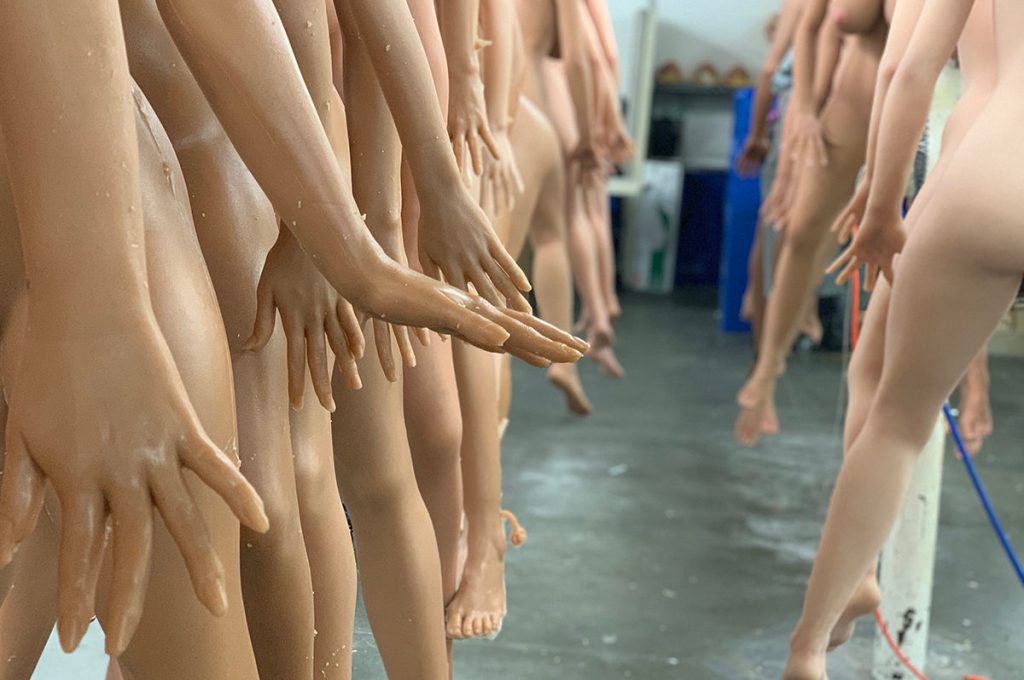This article is in
The Spectator’s November 2019 US edition. Subscribe here.
The floor is slippery. I guess I shouldn’t be surprised, I’m taking a tour of Abyss Creations, the factory where the ‘Ferraris of love dolls’, RealDoll and Realbotix, are made. A thin layer of silicone coats almost every surface. A (real) woman in her late twenties, the PR coordinator, Catherine, shows me round. She has the attitude of a hostess at a theme-park restaurant: bored or stoned or maybe both. I’m sure she’s given hundreds of these tours, heard the same dumb jokes a million times and watched us all slap the ass of a doll reluctantly yet instinctively.
Sex robots went mainstream this year when comedian Whitney Cummings incorporated a lookalike sex robot into her set at the end of her Netflix special Can I Touch It? But my fascination with sex dolls goes back to 2007 when I saw the film Lars and the Real Girl. In it a socially awkward introvert played by Ryan Gosling tells his family he’s met a woman online and when they meet ‘her’ it turns out she’s a life-size real doll. Gosling’s doctor advises the family to go along with it for his mental health and a touching blend of drama and comedy ensues.
But what I’ve always found the most fascinating about the sex doll, what Lars and the Real Girl captures so well, is how lonely the human condition can be and what lengths we will go to for companionship. If you have any doubt, consider how many billions we spend on our pets. Robots are not unlike pets, only more disturbing.
As I set out on the two-hour drive from Los Angeles to San Marcos to meet with CEO and creative director Matt McMullen, I imagine a huge warehouse with floor-to-ceiling armies of fembots; fembots who will someday become sentient, rise up and kill us all. I assume I am going to look my future killer in its dead eyes and meet the menacing forces behind this abomination.
The actual sex doll factory, and the people working there, aren’t what I envision at all. I arrive at a modest, two-story building that looks more like the kind of place you go to for pool supplies or to see a therapist. The entire staff is on break in the lobby when I show up and the AI team has just arrived from various parts of the world. They don’t appear maniacal; most of them look like a collection of SoCal punks straight out of central casting. If it weren’t for the wall of doll lip options and the small, handwritten sign at the front desk that reads, ‘FemBot Pussy Resistance is Futile’, you might think you’re walking into a tattoo parlor.
The dolls immediately evoke a lot of mixed sensations for me, as they do for most people — some personal and others that can best be described as primal heebie-jeebies. Robotics professor Masahiro Mori called that chasm between nearly human and fully human ‘the uncanny valley’. The general idea is that the more human a robot looks, the more humans can empathize with it — until it starts to look too human, at which point it triggers feelings of revulsion.

Touring the RealDoll facilities was a journey through the uncanny valley. It begins with the gaze: the dolls look through you, not at you. Which makes me wonder: what kind of creep wants to engage in coitus with an inanimate object? It strikes me as the ultimate form of female objectification — literally just an empty vessel who can’t talk back, express pleasure, feel pain. I’m reminded of an Elliott Smith line: ‘She shows no emotion at all. Stares into space like a dead China doll.’
The people working on these dolls aren’t sweaty deviants. They’re artists, craftsmen and scientists. They take pride in their art — every single doll is custom made to order — and making sure the dolls look as real as possible takes time; it means adding dimples, imperfections and birthmarks. (Ironically, they struggle to keep up with the work because none of it is automated.)

But something about their optimism is disconcerting. It’s as if I’m in the first act of Jurassic Park and everyone is so excited about doing the thing. No one is stopping to ask if they should.
The employees look at the ‘love dolls’ as more than just sexbots. They know their customers want a couch buddy. They want someone to cuddle at night. Perhaps they’ve lost a spouse and don’t feel like dating.
Whitney Cummings logged on to a forum for men who own the sex robots and monitored their conversations for months. ‘I thought they were going to be creeps, psychopaths,’ she says. ‘I don’t know what to tell you. They’re very lovely men. They’re lovely. They adore their dolls. They marry their dolls. That is happening.’
What strikes me amid the body parts, the rows of eyes, the wall of nipples and the robot ‘brains’: these aren’t your weird uncle’s sex dolls. With the introduction of AI, these dolls are offering something their predecessors couldn’t: intimacy and affection.
‘I always looked at them as art and I always found it funny that because it’s a sexually usable thing, it’s disqualified as art in the higher sense in a lot of people’s minds. They go, “Oh that’s not art, that’s just nasty”’, says McMullen. ‘And what’s funny about that is now we’re doing this serious engineering, artificial intelligence and robotics and now people aren’t so quick to dismiss it.’
Realbotix is the natural evolution of Abyss Creations, the company McMullen started in 1997 (in fact, Abyss Creations made the doll for Lars and the Real Girl). What began as just ‘real dolls’ now has a robotic component, an AI team and an app.
McMullen talks about how he’s always wanted to break free of the sex toy stigma. ‘Yes people use them sexually, but they also get this huge sense of companionship from having a doll and a robot.’
It occurs to me that perhaps the way we view the ‘love dolls’ is just an extension of so many of our hardwired and socially reinforced beliefs about women. Women who are sexy struggle to be taken seriously as thinkers and writers. Women who strip for a living or work in the sex trade are, according to McMullen, viewed as ‘less than human’.

In the case of sex robots — who are very much not human — where is the ethical line? A recent research paper on virtue ethics as they pertain to sex robots suggested the machines should be equipped with a consent module. As the lines between robot and human blur, as we become more dependent on and attached to our virtual lives, it feels as if we aren’t that far away from the hashtag #robotlivesmatter.
‘Have you ever seen the movie Her?’ I’m sitting down with Dr Kino Coursey, one of the members of the AI and VR development team, to ask him about the future of the product. ‘That’s the way to think about it.’
The 2013 film Her is about a recently divorced man (Joaquin Phoenix) who falls in love with a persona called ‘Samantha’, who is really just AI software that exists in the cloud. Realbotix is taking this idea to the next level and giving it a physical form. Through the app you can specify physical characteristics and different personality traits. For example, you can create a brunette with green eyes, big breasts, a tiny bum and a Scottish accent who is unpredictable, sensual, jealous and spiritual.

‘You create the character, the character lives in the cloud somewhere and can either be accessed online or through the phone or through the robot. So it’s one character with multiple output mediums,’ Coursey tells me. ‘So you could interact with the character independently of the doll and that’s what some people are doing and what the beta testers are doing right now is that they are getting the app and interacting with it directly.’
Realbotix is now making its dolls more time-sensitive and interaction-sensitive. So, for instance, she takes into account what time you have a meeting that day and starts sending you text messages when you leave or when you’re done she might ask you how it went.

For some reason, it’s this sort of automated intimacy that really chills my spine and sends me deep into the shadows of the uncanny valley. It’s not the rows of dolls strung up on meat hooks, waiting to be packaged in their coffin-sized crates and shipped off to destinations all over the world. It’s not the dead-eyed robot gaze or the soft silicone ‘skin’.
It’s the fact that human affection, passion and emotions are being reduced to code and algorithms. The human experience of love, companionship and unconditional acceptance we often expect from our pets is being hacked, replicated and ultimately replaced by dolls who live in the cloud during the day and function as your robot wife/sex slave/ couch buddy at night. She can be anything you want her to be and demands nothing (unless you want her to). Soon she’ll be able to make sandwiches. I can’t help but wonder if a large majority of men won’t opt for the conflict-free humanoid over the real thing, with all of our baggage and hormones and mothers-in-law.
This article is in The Spectator’s November 2019 US edition. Subscribe here.


















